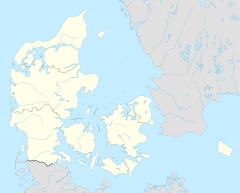
Summary
Aarhus Central Station (Danish: Aarhus Hovedbanegård, abbreviated Aarhus H) is the main railway station serving the city of Aarhus, Denmark.[1][2] Serving as the main connecting hub for rail traffic between Aarhus and the rest of Denmark, the station is used by an average of 6.3 million people per year, making it the busiest station in Denmark outside the Copenhagen area. It is located in the city centre between the districts of Midtbyen and Frederiksbjerg with entrances from Banegårdspladsen and the shopping centre Bruun's Galleri, and with access to platforms from M.P. Bruuns Gade.
Aarhus Central Station Aarhus Hovedbanegård | ||||||||||||||||||||||||||||||||||||||||||||||||||||||||||||||||||
|---|---|---|---|---|---|---|---|---|---|---|---|---|---|---|---|---|---|---|---|---|---|---|---|---|---|---|---|---|---|---|---|---|---|---|---|---|---|---|---|---|---|---|---|---|---|---|---|---|---|---|---|---|---|---|---|---|---|---|---|---|---|---|---|---|---|---|
| main railway station | ||||||||||||||||||||||||||||||||||||||||||||||||||||||||||||||||||
 Front facade of Aarhus Central Station by night | ||||||||||||||||||||||||||||||||||||||||||||||||||||||||||||||||||
| General information | ||||||||||||||||||||||||||||||||||||||||||||||||||||||||||||||||||
| Location | Banegårdspladsen 1D Aarhus C[1][2] Denmark | |||||||||||||||||||||||||||||||||||||||||||||||||||||||||||||||||
| Coordinates | 56°09′00″N 10°12′17″E / 56.15000°N 10.20472°E | |||||||||||||||||||||||||||||||||||||||||||||||||||||||||||||||||
| Operated by | DSB GoCollective Midttrafik | |||||||||||||||||||||||||||||||||||||||||||||||||||||||||||||||||
| Line(s) | Fredericia-Aarhus Line Aarhus-Randers Line Odder Line Grenaa Line | |||||||||||||||||||||||||||||||||||||||||||||||||||||||||||||||||
| Platforms | 4 | |||||||||||||||||||||||||||||||||||||||||||||||||||||||||||||||||
| Tracks | 8 | |||||||||||||||||||||||||||||||||||||||||||||||||||||||||||||||||
| Other information | ||||||||||||||||||||||||||||||||||||||||||||||||||||||||||||||||||
| Fare zone | 01 | |||||||||||||||||||||||||||||||||||||||||||||||||||||||||||||||||
| History | ||||||||||||||||||||||||||||||||||||||||||||||||||||||||||||||||||
| Opened | 1862 | |||||||||||||||||||||||||||||||||||||||||||||||||||||||||||||||||
| Rebuilt | July 1929 | |||||||||||||||||||||||||||||||||||||||||||||||||||||||||||||||||
| ||||||||||||||||||||||||||||||||||||||||||||||||||||||||||||||||||
| Location | ||||||||||||||||||||||||||||||||||||||||||||||||||||||||||||||||||
 Aarhus Central Station Location within Denmark | ||||||||||||||||||||||||||||||||||||||||||||||||||||||||||||||||||
 | ||||||||||||||||||||||||||||||||||||||||||||||||||||||||||||||||||
It is a through station with 4 platforms. The station is located on the East Jutland railway, and is the terminus of the Grenaa Line and Odder Line. It offers international connections to Hamburg and Berlin, InterCity connections to Aalborg/Frederikshavn and Copenhagen, regional connections to the rest of Jutland as well as light rail services to Grenå and Odder. The train services are operated by DSB, GoCollective and Deutsche Bahn.
History edit
The Danish railway network reached Aarhus in 1862 with the construction of the railway line from Aarhus to Randers, built by the British civil engineering company Peto, Brassey and Betts. The city's first railway station opened on 2 September 1862 to serve as the southern terminus of this new line. It was located near Ryesgade, and encompassed administration buildings and railway works.[3]
In 1884, a new and larger station building was constructed. The second station was built in Neo-Renaissance style by Thomas Arboe and William August Thulstrup and was possibly inspired by Bonn Central Station.[4][5]
However, also this building turned out to be to small for the quickly developing city. The third and current Aarhus Central Station was built in 1927 by the Danish State Railway's architect K.T. Seest as a part of a plan of the whole area around the station.
Station facilities edit
The station itself houses a large ticket kiosk, public toilets, a McDonald's restaurant, two 7-Eleven's, and a couple of other shops, but the station building is also combined with a three-storey shopping centre (Bruun's Galleri) housing 93 stores, restaurants and cafés and a large underground car park.[6] The upper deck of the groundfloor train station holds a shopping arcade (Bruuns Arkade) with more restaurants, and a two-storey bike parking facility.
The square outside the station (Banegårdsplads) has a taxi hub, a bike-share facility, a pharmacy, a money transfer and exchange store, and more shops, kiosks, cafés and eateries.
The railway terminal has a flow of 13 million people per year.[citation needed]
Operations edit
Aarhus Central Station serves the whole of Denmark with inter-city rail and Jutland with regional rail. The regional connections include Herning/Skjern in the west and Struer in the northwest.
Aarhus Light Rail with electric trams opened its first line from Aarhus Central Station in December 2017. It connects with Aarhus University Hospital (DNU) in Skejby. In 2018, a southward suburban rail line to Odder opened, and a northbound section to Grenaa is scheduled for 2019. More local expansions of the system are planned for the near future.
Services edit
The following services currently call at the station:
- Intercity services Frederikshavn–Hjoerring–Aalborg–Aarhus–Fredericia–Odense–Copenhagen–Copenhagen Airport
- Regional services Aarhus–Horsens–Fredericia–Kolding–Esbjerg
- Regional services Herning–Silkeborg–Aarhus
- Local services Struer–Skive–Viborg–Aarhus
- Local services Skjern–Herning–Silkeborg–Aarhus
- Light rail/tramway Odder–Aarhus–Lisbjergskolen/Lystrup
- Light rail/tramway Odder–Aarhus–Skødstrup–Ryomgård–Grenaa
Gallery edit
-
The second station in Aarhus in 1905
-
Entry facade of the present station
-
Entrance Hall
-
Departure Hall
-
Groundfloor train station
-
Outside stairways connecting the street level (upper deck) and the railway yard
-
Bike parking corridor (upper deck)
-
Railway Yard, arrival
-
Railway Yard, departure
See also edit
References edit
Citations edit
- ^ a b "Aarhus H" (in Danish). DSB. Retrieved 10 May 2021.
- ^ a b "Aarhus H" (in Danish). GoCollective. Retrieved 20 April 2024.
- ^ Jensen 1972, p. 17-19.
- ^ Christiansen, Asger. 1884: Ny hovedbanegård i Aarhus", Jernbanehistorisk Årbog 2009.
- ^ Østerby, Mads (1984). Danske jernbaners byggeri. Et rids af et forløb (1844-1984). Odense Universitetsforlag.
- ^ "Bruuns Galleri". Retrieved 10 October 2018.
Bibliography edit
- Jensen, Niels (1972). Danske Jernbaner 1847–1892 (in Danish). Copenhagen: J. Fr. Clausens Forlag. ISBN 87-11-01765-1.
- Jensen, Niels (1978). Østjyske jernbaner (in Danish). Copenhagen: J.Fr. Clausens Forlag. ISBN 87-11-03852-7.
Further reading edit
- Gardner, Nicky (2 November 2022). "Rail route of the month: the slow train to Skagen, Denmark, where the North Sea meets the Baltic". The Guardian. Retrieved 4 November 2022.
External links edit
- (in Danish) Banedanmark – government agency responsible for maintenance and traffic control of most of the Danish railway network
- (in Danish) DSB – largest Danish train operating company
- (in Danish) GoCollective – private public transport company operating bus and train services in Denmark
- (in Danish) Danske Jernbaner – website with information on railway history in Denmark


